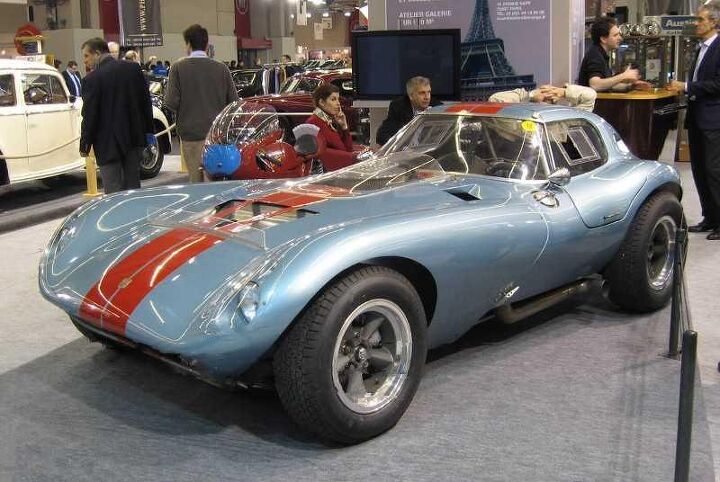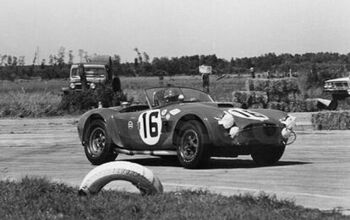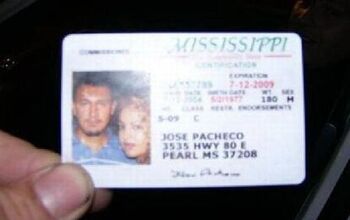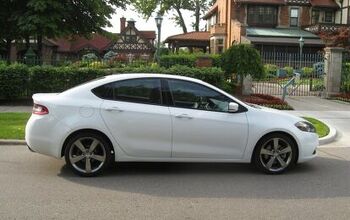The Cobra And The Cheetah: A Muscle Car Tale (Part Two)

Part One of this piece can be found here.
Were it not for an act of God, the fecklessness of General Motors’ executives and the difference between a self-promoting Texan and a Californian willing to walk away from it all, the many Cobras you see, real and ersatz, would be joined by another predator, Bill Thomas’ Cheetah.
Developed with backdoor assistance from Chevrolet, the Cheetah was the Chevy powered answer to the “Powered by Ford” Cobra. A racing Cheetah was given one of the first Gen IV big block 396 Chevy “rat” motors made. Based around Corvette drivetrain and suspension components, and a not very robust tube frame, the Cheetah was covered in a body that is unforgettable.
Though the Cheetah only competed in a small number of SCCA races, winning 11 events while simultaneously developing a reputation for extreme speed but treacherous handling (caused by the flimsy chassis), its drop dead gorgeous body styling made it instantly memorable. The fact that the Cheetah came out in the mid 1960s, when scale models and slot car racing were hugely popular with teen baby boomers, didn’t hurt the car’s popularity.
Don Edmunds, who later went on to build over 600 race cars, laid out the basic components and then sketched a coupe body around them. For good weight distribution, they used the front mid engine layout, with the entire engine behind the front axle line. Mid-engine cars were starting to become state of the art in racing, however the needed transaxles were expensive and fragile. Mounting the engine up front but as far back as possible kept the main mass inside the wheelbase, but allowed the use of conventional transmissions and rear ends. The Cheetah took this concept to the extreme. The front of the engine was a full two feet behind the front axle line, allowing Thomas and Edmunds to completely eliminate the driveshaft. The Muncie 4 speed’s output shaft was hooked directly to the U-Joint at the front of the differential. It made for outstanding weight distribution but also cramped seating and sometimes unbearable heat from the engine and transmission sitting right next to the driver. The foot box sat between the engine block and the headers, which exited out the side of the car.
With those proportions set, Edmunds drew a tight coupe body, with minimal overhangs and an extreme turn under. At first it looks like it could be a caricature of a sports car, a cartoon, but no, the car exists and runs. If it was a cartoon, it would, by the way, run on Adult Swim, not Nickelodeon. The Cheetah is sex on wheels.
[Author’s note: The following should be viewed in the context of how TTAC got started. Robert Farago founded The Truth About Cars after he got fired from his newspaper gig for describing the front end of the Subaru Tribeca as looking like a vagina.]
The Jaguar E-Type’s long hood has often been described as phallic. The E-Type coupe’s teardrop passenger compartment adds a scrotal sack to the long hood’s phallus. Well if the E-Type is a phallic symbol, the Cheetah is a well endowed phallic symbol on Viagra. As with most sexy cars, there is also some femininity in the Cheetah’s shape as well. Some of those ’60s Ferraris are very sensually styled, but the Cheetah is the BSD of hot ’60s cars.
I don’t think the relationship between the Jaguar and the Cheetah looks are coincidental. Thomas did choose to name his car after a faster big cat than the jaguar, and the cars do share the same general profile.
The E-Type has a 96 inch wheelbase and is about 14.5 feet long. The Cheetah is a much shorter car. The wheelbase is 90 inches and the overall length just under 12 feet. Still the hood of the Cheetah looks even longer than that of the XKE.
One of the important dimensions car designers set when first drawing a car is the relationship between the front wheel and the base of the windshield. Because the Cheetah’s engine is so far back in the chassis relative to the front axle, the axle to cowl distance in the Cheetah is just about as long as that of the E Type, a much longer car (the E has a long hood because of the inline 6 cylinder engine). Though the Jaguar has a much longer front overhang and a front end that is measurably longer than the Cheetah’s, the visual effect of the Cheetah’s styling is that it looks stretched compared to the Jaguar. The cowl and passenger compartment look pushed back. The Cheetah is also girthier than the E Type. Track is about 8″ wider and overall width about 4.5″ wider. Keeping with the sexual imagery, the Cheetah’s front fender swells as it arcs over the wheels. Those fender swells, combined with the rear fender haunches, add a female flavor to the car’s shape, suggesting a bust and hips.
By the way, I’m sure that Edmunds and Thomas would have laughed at all this sex talk. They just built a cool looking car.
The Cheetah’s passenger compartment is more compact and than the E-Type’s. Unlike the E-Type, whose tires & wheels are somewhat obscured by bodywork, the Cheetah’s wheel openings are fully exposed, giving the car a more aggressive look.
Like the Shelby Daytona Coupe, there’s not a bad angle on the car. The shapes of the panels flow seamlessly into each other. Just about every shape of the car is sensuous. The panel that continues the cowl down the side of the car in front of the gull wing door is a work of art all by itself. Viewed from the front, the car is low, almost sinister looking, a predator crouching. From the side, the rear end looks coiled for action and the long hood evokes speed. In nature, cheetahs (and greyhounds) are fast because they have powerful thighs and long spines that allow them to extend long leaping strides.
While it wasn’t perfect, the Cheetah was visually arresting and stunningly fast.
The Cheetah’s shortcomings were mostly due to the fact that it was not really designed to go hunt Cobras. Though many accounts say that the Cheetah was specifically conceived by GM as a Cobra beater, it’s not clear that was really the case. Certainly, once its speed was obvious it was a logical choice to use to go racing with the Cobras. On Daytona’s high banks the Cheetah did 215 mph, so it was undeniably fast. On the other hand, the idea that GM management would pay a privateer to go racing against Fords at a time when Zora Duntov’s racing Corvettes weren’t exactly getting wholehearted support from the suits is dubious.
According to people close to him (later in life Thomas himself avoided speaking about Cheetah) Thomas’ original plan was to make money selling cars that were more fast boulevard cruisers than purpose built race cars. Though the factory did some developmental track testing and racing with Jerry Titus at the wheel, as well as a little bit of factory drag racing, almost all Cheetah racing was done by privateers.
The Cheetah came to be because Thomas wanted to do more business with Chevy. He already had a working relationship with some people at Chevrolet. He had raced a team of Corvettes and built special events vehicles with Bill Stroppe for Chevrolet marketing. Stroppe decided to concentrate on projects for Ford, so Thomas hooked up with Bill Edmunds and Don Borth to do the work for Chevy. To demonstrate what they could do, they built a 1962 Chevrolet sedan for Dan Gurney to drive in the inaugural USAC stock car race at Riverside (way back when, USAC had a series to compete with NASCAR). The car came in 1st and 2nd in the two heats, winning the overall, but USAC disqualified them for some chassis mods and Thomas decided to switch to sports car “specials” that could compete in the SCCA. The idea wasn’t to go racing, though, it was to make money selling the cars.
Thomas’ connections with Chevrolet meant a supply of the latest Corvette performance components. The Cheetah used ‘Vette steering knuckles up front, attached to some rather spindly looking tubular A arms that were fabricated in-house and were controlled by coilover shock absorbers. In the back, the stock Corvette suspension and rear end was used, with the Corvette’s transverse leaf spring was swapped in favor of coilover units. Disc brakes were in short supply, so the early Cheetah used heavy duty finned Chevy drums with sintered linings. Later, discs were fitted. The first three cars had fabricated aluminum body panels. After that, molds were pulled and the remaining cars were made of fiberglass.
This was around the time that Zora Duntov was working on the lightweight Grand Sport Corvettes, and part of Thomas’ back door cooperation with GM meant that Cheetah #1 was purchased by the automaker (some accounts say it was Cheetah and shipped back to the Warren Tech Center. Duntov and his colleagues found that the car had outstanding grip on the skid pad, but that the frame was not torsionally rigid. Later, after the Cheetah was raced, teams would discover frame members displaced as much as 75mm after races and most would add stiffening triangulation and gussets to try to make their cars stiffer. The original frames used 1 1/8″ 4130 chromoly steel tubing with a 0.063″ wall thickness. That’s in a car that weighed 1700 lbs and had at least 400 HP. That tubing today would be considered unsafe for building a 1200 lb Lotus Seven replica. Most “Locosts” are built with 0.095″ tubing. The folks who build Se7ens with V8 power (yes, Virginia, there are LSx powered Se7ens) use inch and a half diameter tubing as well.
Customer cars sold for $7,500 to $12,000 in 1965 era dollars. A homologation run of 100 copies, to satisfy the SCCA, was planned.
Thomas, though, didn’t have good fortune like Carroll Shelby whose patron in Dearborn openly worked with racers. GM officially did not support racing, so Thomas’ continued supply of components was based on handshakes, personal relationships and stuff getting shipped out the back door. It was similar to the relationship Jim Hall and Hall Sharpe of Chaparral had with Chevrolet. Technology transfers went in both directions, but everyone had to keep quiet about it to keep the suits out of the loop so they wouldn’t shut it all down. Apparently Hall was better at the game. Perhaps because of the Chaparral team’s many innovations (including using a Powerglide based automatic transaxle) were proprietary, Hall’s secrecy was legendary. Hall wanted to win races. Thomas, though, wanted to sell cars. To sell cars you need publicity. Publicity can be a two edged sword. After an 8 page spread appeared on the Cheetah in Hot Rod magazine, GM executives, already skittish about backdoor sponsorship of racing, put the kibosh on supplying engines to Bill Thomas Race Cars. Not long afterwards, a fire at the Cheetah shop destroyed most of the tooling and molds. Only 23 Cheetahs were built, of which at least 8 survive. Thomas got out of the car business in 1969, started investing in real estate, and died in October of 2009.
As I said, though they didn’t build many Cheetahs, the car was popular and stuck in people’s minds. Some folks don’t want to drive just another Cobra replica, even if the replica can do sub 4 second 0-60 runs. It should come as no surprise that there are people who build Cheetah replicas too. After Bill Thomas got out of the business Dean Morrison bought the rights and some tooling for the Cheetah, and later sold them to Buford Everett in 1983. Everett’s family business continues to make Cobra replicas but it’s not clear how many Cheetahs they and Morrison produced.
Ruth Engineering & Racing, makes what they say is the first “streetable Cheetah” kit, with a properly engineered chassis and attention paid to isolating heat from the passenger compartment. You can buy a body kit for about $18K and an assembled rolling chassis that uses C4 Corvette components plus the body kit for $39,500. It may be streetable but first you’ll have to come up with your own interior and wiring harness. RER says that they can fit brackets for any Chevrolet V8 so if you want to use a SBC with Edelbrock heads and a big carb, a LT1, a LSx, or even an old school 396/454 big block rat motor, you can run your choice of bow tie engines.
Carroll Shelby’s own continuation Cobras and his licensing deal with Superformance shows that while style is important some folks will pay extra for authenticity. It’s not just the value of the provenance of an authorized replica. Vintage racing has become serious business and if a manufacturer wants to be able to get competition approval, it’s best if they have the cooperation (and the original blueprints) of the vehicle’s originator.
Before Bill Thomas’ death he was fortunate to see the Cheetah reborn. In 2001 Robert Auxier was licensed by Thomas to recreate and sell the authorized “ Bill Thomas Cheetah Continuation Turnkey Collectible” and the car is built and sold by Auxier’s company, BTM LLC of Arizona. For safety reasons, the continuation Cheetah is not an exact duplicate. Shortcomings with the frame and front suspension have been rectified, with thicker tubing and more stiffening members welded into the frame.
Other than that, the car is identical to those built in 1964. Fixtures were built from measurements taken from an original frame, and molds were pulled from an original Bill Thomas built car. Even the interior is original design. Though Thomas had the original blueprints to help with the architecture of the Cheetah, the interior was not well documented. Fortunately one of the eight surviving original Cheetahs has an original interior, so that was copied.
The continuation Cheetah has already surpassed the success of the original, with Auxier reporting having sold 32 and delivered 30 cars by the end of 2009, at a price between $80,000 and $100,000 depending on engine and whether it’s for the street or track. The buyers are a mix of collectors and vintage racing enthusiasts.
Cars intended for racing get additional upgrades: more gusseting, more tubing, different suspension components, different shocks, an oil cooler, a better engine, better clutch, and a fuel cell/fire system. The continuation Cheetahs are already being raced in North American vintage racing and BTM LLC is working with the FIA to allow the new Cheetahs to be used in international competition. Auxier says that having Thomas as part of the project made the process much easier.
At the time of his death, Thomas had signed 100 certificates of authenticity for the continuation cars. It’s not clear what BTM will do should production reach 100. Considering how many Cobra replicas there are, it wouldn’t be terrible if BTM made a continuation of the continuation. Though GM stopped supplying engines the first time around, if you think about how the automakers have been working hard to market both current and vintage crate motors, this time I think that GM Performance will sell them all the engines they can use. I’ll take my Cheetah with a LS9 and a Tremec 6 speed.

Ronnie Schreiber edits Cars In Depth, the original 3D car site.
More by Ronnie Schreiber
Latest Car Reviews
Read moreLatest Product Reviews
Read moreRecent Comments
- Calrson Fan Jeff - Agree with what you said. I think currently an EV pick-up could work in a commercial/fleet application. As someone on this site stated, w/current tech. battery vehicles just do not scale well. EBFlex - No one wanted to hate the Cyber Truck more than me but I can't ignore all the new technology and innovative thinking that went into it. There is a lot I like about it. GM, Ford & Ram should incorporate some it's design cues into their ICE trucks.
- Michael S6 Very confusing if the move is permanent or temporary.
- Jrhurren Worked in Detroit 18 years, live 20 minutes away. Ren Cen is a gem, but a very terrible design inside. I’m surprised GM stuck it out as long as they did there.
- Carson D I thought that this was going to be a comparison of BFGoodrich's different truck tires.
- Tassos Jong-iL North Korea is saving pokemon cards and amibos to buy GM in 10 years, we hope.







































Comments
Join the conversation
Yes, there was at least one Cheetah built with the 396, but they otherwise were all built and raced with the small block 327, commonly enlarged to 377.
I don't understand running original cars with continuation/replicars in Vintage racing. Something built 50 years later sure should be better/faster.